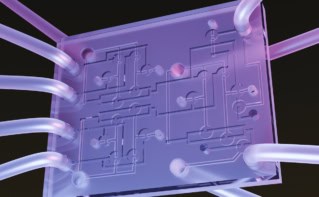
Body-temperature control, self-assembly, vapour-mediated sensing, energy harvesting and emulsification are just some of the processes that hinge on evaporation. Little wonder then that the mechanisms underlying water evaporation and related surface effects, such as wetting, have attracted intense research attention.
Scientists have been keen to investigate the effect of graphene on the evaporation process, since the interaction between the droplet and the substrate is known to play a critical role. So far, however, the results have been inconclusive, with some studies suggesting that graphene increases the wetting angle, while others indicate that graphene has no effect at all – in other words, it is wetting transparent.
A new study by researchers at the Chinese Academy of Sciences and the Collaborative Innovation Center of Quantum Matter in Beijing, China, has now investigated the effect of a graphene layer on wetting and evaporation. Yongfeng Huang, Jun Lu and Sheng Meng used a single layer of high-quality graphene produced through chemical vapour deposition, and tested its effect on the behaviour of water on four hydrophilic (water-attracting) surfaces plus one that is hydrophobic. When they added the layer of graphene to the surfaces, they found that the contact angle increased for hydrophilic surfaces and decreased for hydrophobic surfaces.
The contact angle is an important parameter, since droplets evaporate according to two main regimes: one where the diameter of the droplet in contact with the surface remains constant while the contact angle decreases, and one where the contact angle of the droplet with the surface remains constant but the contact diameter decreases. Any change in wetting angle has a knock-on effect on the contact diameter of a droplet, so the increase in contact angle observed for the hydrophilic surfaces should cause a droplet with the same volume to have a shorter contact diameter.
The researchers monitored the contact angle, contact diameter, and mass of water droplets as they evaporated from surfaces with and without a layer of graphene. The measurements show that the rate of evaporation increases for the hydrophilic surfaces by around 20% and decreases for the hydrophobic surface, as would be expected from the changes in contact angle.
However, the mean evaporation rate per contact length/diameter remains unchanged. For all substrates investigated in the study, the difference in evaporation rate per contact line is less than 5%.

Characterization service promises graphene industry a leg up
Molecular dynamics simulations enabled the researchers to identify the initiation of the evaporation process in a water molecule where it is in contact with the surface. “Since the graphene does not alter the binding energy of a single water molecule, it has negligible effects on evaporation per contact line,” says Huang. The results could be useful for applications that aim to control evaporation, such as heat transfer, printing, and self-assembly.
Full details are reported in 2D Materials.



